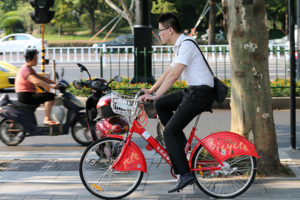
The bike share system in Hangzhou was designed, built, and funded by the local government in order to cover the last kilometer from the public transportation stop to the customer’s destination or vice-versa. Strong local government involvement helps to ensure the financial sustainability of the bike share system, prevent vandalism, and improve the service level.
How the bike rental works
This municipally owned and operated the system which uses a card in conjunction with the city’s bus system and parking. Over 80% of the rental stations in Hangzhou are unmanned service stations. At one of these self-service kiosks, the customer inserts his or her card into the machine unit. Then, a bike is unlocked and the docking station flashes a green light. A deposit of 200 Chinese yuan (22€) is then deducted from the card and the rental period has begun. To return a bike, the customer simply puts the bike in the open slot and places the card in the machine. The deposit is then returned and the rental period is over. The appropriate rental charge is then deducted from the card’s balance.
In May 2008, Hangzhou had 61 bike sharing stations with 2,800 bicycles. One year later, there were 640 stations with 16,000 bicycles. At the end of 2009, there were 2,000 stations with 50,000 bicycles and the system has since expanded to 3,572 stations with 84,100 bicycles as of May 2016. On average, 310,000 people use the service on a daily basis, with the peak daily volume reaching 448,600, according to official statistics. (source: China Daily)
Project Cost Description
The Hangzhou government invested 180 million yuan ($26.35 million) to launch the program, and 270 million yuan ($39.53 million) in discounted loans.
Fuel Displacement Calculations Description
The bikesharing system in Hangzhou appears to be playing an important role in facilitating new forms of travel behavior among residents. This role is evident from the commute patterns of members and nonmembers. Overall, the existing commute profile suggests that public transit and bicycling are major components of commuting behavior within the sample. The sample commuted to work an average of 5.32 days per week; roughly 230 respondents commuted to work 6 or more days per week.
Analysis of bikesharing usage patterns indicated that 70% of bikesharing members used the service in their commute at least occasionally. By contrast, only 30% regularly used it as part of their commute. Members also used bikesharing for nonwork trips related to shopping, entertainment, and other errands. Users can make one-way bike trips between stations and use bikesharing far from home and close to work. As a testament to this practice, 40% of members stated the station they used most is closest to work. Another 40% reported the station they used most was closest to home. The remaining 20% were divided among proximity to school, bus stations, attractions, and scenic locations.
A striking result is that 78% of car owner respondents stated that they used bikesharing for trips previously taken by auto. Roughly 50% of car households also used bikesharing to substitute for bus transit. Among carless households, more than 80% indicated that they previously used bus transit for trips they now take with bikesharing. Furthermore, 60% of carless households substituted walking and 20% substituted taxi trips with bikesharing.
A majority felt they walked more often, made fewer auto trips, saved money on transportation, postponed buying a private bike, liked Hangzhou much more, and felt it was more convenient to bicycle because of bikesharing. A minority felt bikesharing caused them to use public transit more often and made them postpone a car purchase.
Overall, these results strongly suggest that bikesharing is shifting people toward bicycle use. In particular, the system appears to be drawing users from bus transit, auto use, and walking. Bikesharing is improving the modal share of biking at the expense of most other modes. The Hangzhou bus transit system has limited capacity. Bus transit is the mode with the highest use among the sample, and it is the mode from which the greatest share is drawn. Despite growing auto travel in Hangzhou, bikesharing adoption appears to have reduced the total amount of auto trips (private car, taxi, carpool, and motorbike).